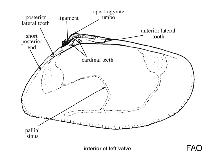Donax serra Röding, 1798
White musselИзображение на Google | No image available for this species;
drawing shows typical species in Donacidae.
Классификация / Names народные названия | синонимы | CoL | ITIS | WoRMS
Bivalvia | Cardiida | Donacidae
Environment: milieu / climate zone / пределы глубины / distribution range экология
. Subtropical
Distribution страны | регионы FAO | Ecosystems | места находок | интродукции
Southeast Atlantic: Namibia and South Africa.
Length at first maturity / Size / Weight / Возраст
половая зрелость: Lm ? range ? - ? cmнаибольший возраст (опубликованны данные): 5 годы (ссылка 8702)
Life cycle and mating behavior половая зрелость | размножение | нерест | Eggs | Fecundity | Larvae
Основная ссылка
ссылки | координатор | соавторы
MarineSpecies.org 2050 MarineSpecies.org. http://www.marinespecies.org/index.php (ссылка 3477)
Статус Красного Списка МСОП
(ссылка 130435: Version 2025-1)
Статус СИТЕС (ссылка 108899)
CMS (ссылка 116361)
Угроза для людей
Использование человеком
рыболовство: потенциальный рыбохозяйственный объект; наживка: usually
| FishSource |
инструменты
дополнительная информация
ресурсы в Интернет
BHL | BOLD Systems | CISTI | DiscoverLife | FAO(Publication : search) | Fishipedia | GenBank (Геном, Нуклеотид) | GloBI | Gomexsi | Google Books | Google Scholar | Google | PubMed | Tree of Life | Wikipedia (Вперёд, поиск) | Zoological Record



